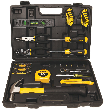When it comes time to install the flooring of your home, you really only have two choices. The first choice is to hire someone else to do the work for you. While this may be the most traditional method, and one that can almost certainly guarantee your satisfaction, it is also one of the more expensive options. The second, and most cost effective, method is to do your own work.
- Preparation. One of the most important steps in installing wood flooring is the preparation that you put into the project before you actually do any installation. Hardwood flooring needs to be installed on a subflooring or flooring base that is dry, clean, smooth, level, and structurally sound. While you are ensuring that your flooring base or sub floor will fit these parameters, bring in the wood for your flooring into a different room of your home. This will allow the flooring to adjust to the humidity levels prior to installation, and allow you to work with the wood without fear of later warping.
- Layout. Find out which direction the floor joists are traveling in, and get ready to install the wood flooring so that it will be perpendicular to these joists. Make marks along the walls where the joists are located with a pencil so that you can easily erase the mark later on. Lay down a layer of 15 pound asphalt laminated kraft paper for a vapor barrier, as well as reducing the amount of noise that the flooring will make when you walk on it.
- Start the first few rows. When installing wood flooring it is always a good idea to first layout the first three rows in a sort of dry run. Before you lay down these rows, use a measuring tape to determine where the middle of the room is on the wall that you will be starting at. Repeat the process on the opposite wall. Connect these two marks with a chalk line, and double check to ensure that the measurements are the same. Use this guideline to ensure that you are moving in a straight line as you laydown the flooring. Turn the first row of flooring so that the groove is towards the middle of the room, you will want to cut off the tongue using a table saw so that you have a flat straight edge to work with. Between this first row and the wall, place a 1/2 spacer to create an expansion gap (which will be covered by the base molding when you are finished). Nail the flooring into place with 1-1/2 inch finishing nails that are three inches from the ends of the plank, and about 1/2 inch away from the groove, spaced six inches apart from each other. Make sure that the nail heads are just below the surface of the wood with the help of a nail set. Repeat the process for the remaining first row, and then offset the second row so that the seams do not line up (they should be staggered by about six inches for maximum effect). Make sure to fit the tongue of the second row into the grooves of the first, and then nail about three to four inches from the end, and every eight inches along the length. Your best bet would be to nail into the floor joists themselves for maximum strength. Repeat this process with the third row.
- Repeat until your last row. Dry fit (meaning you don't nail down like you did the first three rows) the next five rows of flooring. Instead, use a pneumatic nailer to blind nail the floor boards into place. You should be about half way across the floor at this point, so repeat the same process that you did with the original two rows once again, and then repeat the dry fitting technique for another five rows. You should now be about two rows away from the opposite wall that you started on.
- Final row installation. For the installation of the final couple of rows, you will want to repeat the same process as with the first couple of rows, but in reverse. This means that with the row that will be closest to the wall you will want to cut off the groove, or more if the measurements require it) so that you have a flat surface. Once again, make sure that you are using a 1/2 spacer between the flooring to a expansion gap. You have now finished installing wood flooring, and all that you have left is some cleanup and a little finishing work.
Author Bio
Lee Wyatt
Contributor of numerous Tips.Net articles, Lee Wyatt is quickly becoming a regular "Jack of all trades." He is currently an independent contractor specializing in writing and editing. Contact him today for all of your writing and editing needs! Click here to contact. Learn more about Lee...
Driving Off-Road
Off-road driving can be an extremely fun and adventurous activity. Here are some basic tips for the budding off-road ...
Discover More
Waffle Irons
Waffles are a long standing favorite food all over the world. In fact, waffles are so famous that certain types of ...
Discover More
Estimating Wallpaper
Do you have a wallpapering project that you need to do? Before you can actually begin hanging your wallpaper, you will ...
Discover More
More Home Improvement Tips
Cork Flooring
If you are looking for a beautiful and environmentally friendly type of hardwood flooring, you can't really go wrong with ...
Discover More
Laying Ceramic Tile
If you are thinking that your home may need a bit of a change then you may want to consider laying some new ceramic tiles ...
Discover More
Removing Tile Adhesive from Tile
While you could remove old tile adhesive from tile with steel wool or a putty knife, you take the chance of scratching or ...
Discover More

Comments